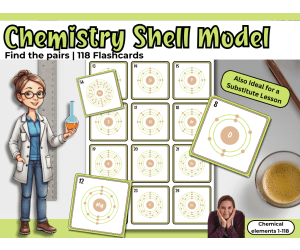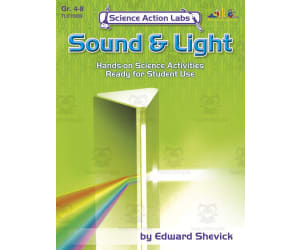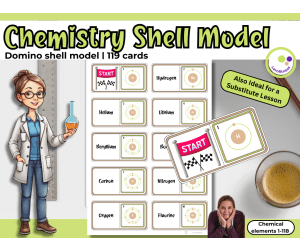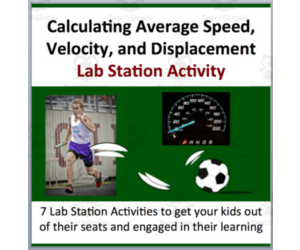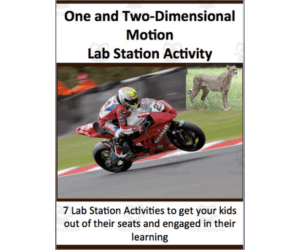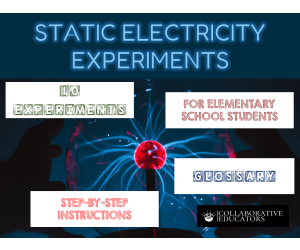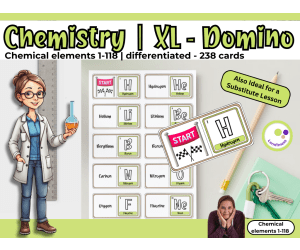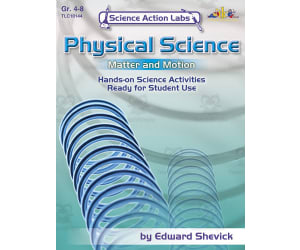2,742 products added recently
Physics Experiments
Unlock the mysteries of physics with experiments that bring concepts like motion, energy, and forces to life. This collection includes activities such as building simple machines, exploring magnetism, and observing wave behavior. By incorporating these physics experiments into your teaching, you can help students grasp complex ideas through practical application.
Shell Model – Chemistry Flashcards Without Element Names
STEM, Science, Chemistry, Physics, Life Sciences, Grade 7, 8, 9, 10, 11, 12, Activities, Games, Worksheets & Printables, Task Cards, Quizzes and Tests, Teacher Tools, Word Problems, Flashcards, Escape Room, Experiments
Shell Model – Chemistry Flashcards Without Element Names 118 cards for learning the periodic table Visual practice with atomic structure and electron configurations 🧪🔬 This printable flashcard set gives students a hands-on way to practice atomic structure and the shell model – without revealing the element names. Each of the 118 cards shows the atomic number, the chemical symbol, and a diagram of the electron distribution across shells. This encourages students to actively recall element names and deepen their understanding of how atomic structure relates to the periodic table. I’ve used these cards mainly for review and partner quizzes. Students really have to think: “What element has 11 electrons and that shell pattern?” or “Which group might this symbol belong to?” It shifts the focus from just memorizing the periodic table to actually understanding the structure behind it. What’s included: 118 printable flashcards (PDF) Each card includes: atomic number, symbol, and shell model (no element names) High-resolution layout, easy to print and cut Suggestions for classroom use included Classroom ideas: Use the cards as a “Find the Pairs” game: Print two sets and let students match identical cards or group elements by patterns. Use them for sorting tasks: metals vs. non-metals, main groups vs. transition metals, increasing number of shells, etc. Create mini-quiz stations: One student shows a card, the other has to guess the element name or describe properties based on the shell model. Let students use the cards to quiz themselves or work in pairs for peer learning. The fact that the element name is missing makes the activity more cognitively demanding – great for more advanced learners or as a follow-up to a unit on atomic structure. Students are more engaged when they can “figure things out” rather than just read off answers. The resource is ready to print. For repeated use, laminating is recommended. 📍 Best wishes, Heike from @Lernfitness Did You Know? I teach with a certified therapy dog, and together we create a positive and welcoming learning environment. 🐶
Author Lernfitness
Rating
Tags Educational Card Games, Chemistry, Physics, STEM Science Matching Game, Chemical Elements, Periodic Table Matching Game, Flashcards Chemical Elements, Shell Model, Game
Easter Chemistry Bunting - Learn Chemical Elements with Festive Banner
STEM, Science, Chemistry, Physics, Life Sciences, Biology, Grade 6, 7, 8, 9, 10, 11, 12, Activities, Worksheets & Printables, Banners, Classroom Decor, Bulletin Boards, Door Decor, Posters, Word Walls, Labs, Experiments
Easter Chemistry Bunting A Fun & Educational Decoration for Your Science Classroom! 🐰🔬 I love decorating my classroom for different seasons, but I also want my decorations to be educational and useful. That’s why I created this Easter Chemistry Bunting—it brings a bit of spring energy into the classroom while helping students get familiar with the periodic table! Each pennant features an element symbol, name, and atomic number, so students see and recognize them every day—without even thinking about it. It’s such a simple way to reinforce learning while brightening up the room! 🌸 Why This Works So Well in Class ✔ No extra work for you – Just print, cut, and hang. ✔ Students see chemistry every day – Without pressure, they start recognizing elements naturally. ✔ Festive, but not distracting – A bit of color and seasonal fun, while still focused on learning. ✔ Perfect for any science room – Whether in a chemistry class, lab, or hallway, it works anywhere. ✔ Easy to use in lessons – You can even make it interactive with a classroom game! 📌 What’s Included? 📜 127 Printable Pennants – One for each element, showing: ✔ Symbol ✔ Name ✔ Atomic Number 🎨 Colorful, Easter-Themed Designs – Cheerful and bright, but still focused on learning. 🖨 Easy to Print & Adjust – Scale it to fit your classroom space. 📎 Two Hanging Options: ✔ String them together for a banner. ✔ Attach with fasteners for a flexible display. 💡 Ideas for Using It in Class 1️⃣ Print and cut the pennants. 2️⃣ Hang them up in your classroom, hallway, or science lab. 3️⃣ Use them for a quick challenge – Call out an atomic number, and students find the right pennant! 💡 Another idea: Assign an element to each student and have them share a fun fact about it. 🐣 Why Other Teachers Like It ✔ “Students actually look at it and ask about elements—great conversation starter!” ✔ “A simple way to make the classroom feel more engaging.” ✔ “No prep, looks great, and makes chemistry more visible every day.” 🔬 Bring Chemistry into Your Easter Decorations! Instead of just hanging up generic classroom decorations, why not make them meaningful? This bunting adds a touch of spring while keeping students engaged with science. 🚀 Try it out and see how it works in your classroom! 📍 Best wishes, Heike from Lernfitness Did You Know? I teach with a certified therapy dog, and together we create a positive and inspiring learning environment. 🐶✨
Author Lernfitness
Tags Chemistry, Lab, Biology, Laboratory Equipment, Lab Tools, Physics, Bunting, Pennant Banner, Classroom Banner, Chemical Elements
Liquids and Gases – Lab Station Activity
Science, Physics, Grade 6, 7, 8, 9, Labs, Experiments, Activities
Liquids and Gases – Lab Station Activity is a valuable educational resource designed to enhance classroom learning for middle and high school students, especially those studying physical science. This affirmative lab activity engages students with an in-depth examination of Earth's biomes, promoting student movement and interaction. What sets this comprehensive resource apart is its coverage of critical topics like: Biome Types, Aquatic areas, Grasslands, Forests, Deserts, Tundra, etc., Beyond passive learning, different stations offer tasks that engage students actively, teaching them through the process of doing. The task may range from"drawing", or"constructing at one station", to developing their own comprehension testing queries at another. The way these stations function: Drawing or Construction tasks which require creativity. Involves research where children can look into pre-set questions about relevant subjects using either classroom computers or personal devices. , Inclusion of writing activities where participants express their formulated opinions cohesively in paragraphs form. . To counterbalance workload: We've got rest stations designed for reviewing prior content or preparing for future sections. More so there are real-life-based activity sections that lean into reading articles. Testing: The curriculum is reinforced with multiple-choice quizzes. Media-based Learning: Includes video content with corresponding questionnaires to further grasp comprehension level. Create your own Quiz Station: This exciting station allows students to both answer pre-set quiz questions and devise their student quizzes by creating multiple choice true/false queries alongside short response questions! For an elevated learning experience, word scramble and word search games have been cleverly interposed between activities; this sustains learner engagement and eradicates classroom monotony. Finally, Liquids and Gases – Lab Station Activity accounts for teachers' convenience too! Without requiring any elaborate preparations or setup hassles, even fully ready to print when needed! With its interactive nature, this lab activity could be easily incorporated into whole group studies, small group explorations, pair work or given as homework assignments. This makes it is versatile enough useful whether you're a public school teacher looking to provide engaging instruction or a homeschooler seeking varied resources.
Author Teach With Fergy
Tags Liquids, Gases, Lab Activity, Ecosystems, Hands-on Learning
GHS Pictogram Clipart – Glitter Design for Chemistry Classrooms & Craf
Common Core, Science, STEM, Chemistry, Physics, Life Sciences, Earth and Environmental Sciences, Technology, Basic Science, Resources for Teachers, Homeschool Templates, Homeschool Curriculum, Grade 10, 11, 12, Classroom Decor, Bulletin Boards, Posters, Teacher Tools, Word Walls, Door Decor, Experiments, Activities, Labs, Worksheets & Printables
GHS Pictogram Cliparts Glitter Design for Chemistry Classrooms, Crafts and Materials PNG If you’ve ever found the standard GHS (Globally Harmonized System) pictograms a bit too plain or uninspiring for your teaching materials, you’re not alone. That’s exactly why I decided to redesign them with a fresh twist. These 18 cliparts—9 in portrait and 9 in landscape format—combine the clarity of the official hazard symbols with a visually striking glitter effect. The colors remain true to the original system (red border, black symbol), but the glitter gives them a unique and eye-catching feel. I created each of these cliparts by hand in Procreate, with the classroom in mind. They’re still clearly recognizable as hazard pictograms, but they add a touch of design that fits beautifully into worksheets, posters, or digital resources. Ways you might use these in your classroom or materials: – Labeling chemical containers in a more engaging way – Gluing into student chemistry notebooks to support safety topics – Decorating posters or bulletin boards about lab safety rules – Enhancing worksheets or lab instructions visually – Adding to PowerPoint, Keynote, or Genially presentations – Integrating into digital learning platforms or safety training resources – Using them in flashcards for visual reinforcement Since you’ll receive both portrait and landscape versions (in PNG format with transparent backgrounds), you can easily adjust them to your layout or format. Whether you're printing or working digitally, the designs remain sharp and flexible. These glitter-style symbols were made to support safety awareness while also respecting visual design preferences—especially for teachers or students who appreciate a bit more flair in their materials. Usage rights: You may use the cliparts both privately and commercially within educational content, as long as your own contribution is clearly visible. Please do not resell the graphics individually. Wishing you lots of creativity while designing your materials, – Heike from @Lernfitness Did You Know? I teach with a certified therapy dog, and together we create a positive and welcoming learning environment. 🐶
Author Lernfitness
Rating
Tags Teaching Materials, Classroom Decorations, Decorative Elements, Cliparts, Illustrations, GHS, Science, Lab, Chemistry, Pictograms
Science Action Labs Sound & Light
Science, Physics, Grade 4, 5, 6, 7, 8, Labs, Experiments, Activities
Science Action Labs Sound & Light An exceptional educational resource aimed especially at students in Grades 4-8, focusing predominantly on engaging physical science subtopics. This easy-to-use workbook captivates the minds of budding learners, stimulating their imagination and curiosity through hands-on experience with sound and light concepts. Participatory learning is favored over mere observation. Students engage in entertaining experiments using commonplace objects like mirrors and flashlights to unpack complex scientific principles in a digestible manner. By interacting with sound waves and light as reflected or emitted from these objects, young minds gain better comprehension of scientific theories. Sir Isaac Newton's wisdom is celebrated throughout the pages of this book. Simplified explanations grounded in his concepts build understanding while additional nuggets of information further enrich knowledge, fostering a lighthearted yet potent educational environment for the pupils. Encouragement is key — plentiful doses are offered while confidently guiding learners on their journey. Versatile Usage The Science Action Labs Sound & Light primarily serves classroom usage during whole-group instruction, but also can work effectively for smaller group engagement - such as after-school science clubs or other similar activities. It even supports homeschooling parents looking to reinforced their current curriculum effectively. Instructor’s Asset For added convenience, this tool includes a single manageable PDF file containing 64 print-ready pages formatted for standard paper sizes . This becomes ideal when preparing assignments or practical sessions need to be straightforward! Besides serving as worksheets that underpin knowledge gained during teaching sessions, these materials could also support homework assignments; thus linking school-based learning into home-time follow-up tuning perfectly. In Summary: The Science Action Labs Sound & Light translates abstract scientific theories into tangible understanding via active tasks. Because truly, nothing embeds learning quite like doing!
Author Classroom Complete Press
Tags Action Labs, Science Labs, Sound, Light, Science Worksheet
Kinetic and Gravitational Potential Energy – Lab Station Activity
Science, Physics, Grade 9, 10, 11, Labs, Experiments, Activities
Kinetic and Gravitational Potential Energy Lab Station Activity This editable 9-station lab activity allows students to get out of their seats and actively learn about kinetic and gravitational potential energy. The hands-on stations engage students through drawing , research, opinion-writing, and more. Questions and reading assignments connect the content to real-world applications. A recording sheet allows students to document their work as they rotate through the stations. This activity can be used to review before a test or as an immersive lab experience. It covers key concepts like kinetic energy, gravitational potential energy, and the conservation of energy. Bonus vocabulary puzzles are included to keep students productive during transition times. Suitable for grade 9-11 physics classes, this lab station activity needs almost no teacher prep and provides an exciting opportunity for students to interact with the content.
Author Teach With Fergy
Tags Kinetic, Energy, Gravity, Conservation, Lab Station, Potential And Kinetic Energy Games Online, Work And Energy Lab, Kinetic And Potential Energy Word Search
Newton’s 3 Laws of Motion – Lab Station Activity
Science, Physics, Grade 8, 9, 10, 11, Labs, Experiments, Activities
Newton's 3 Laws of Motion Lab Station Activity Students will learn Newton's three laws of motion through engaging lab stations. This hands-on physics activity allows small groups to rotate through 8 stations testing their knowledge of concepts like inertia, momentum, and equal-and-opposite forces. Stations feature building challenges, research questions, videos, and multiple choice assessments . A recording sheet tracks student progress as they navigate stations. This customizable resource works for middle and high school grade levels. Use it to introduce, reinforce or review Newton's laws of motion.
Author Teach With Fergy
Tags Motion, Newton, Forces, Objects, Lab Station
Atomic Shell Model Domino – Learning Electron Configurations Play
STEM, Science, Chemistry, Physics, Life Sciences, Montessori, Basic Science, Grade 7, 8, 9, 10, 11, 12, Activities, Games, Worksheets & Printables, Task Cards, Quizzes and Tests, Teacher Tools, Word Problems, Flashcards, Escape Room, Experiments
Atomic Shell Model Domino – Learning Electron Configurations Through Play 118 cards for learning the periodic table A classroom game to practice atomic structure and element knowledge 🧪🎲 This printable domino game helps students explore the shell model of the atom while getting to know the periodic table in a more hands-on and interactive way. Each card connects an element name to a visual of its electron shell configuration, offering a playful way to reinforce key chemistry concepts. The set includes 119 domino-style cards – covering all 118 known elements. On each card, the element name is on the left and the corresponding shell diagram with its symbol is on the right. Students link them by matching the shell model of one element to the name of the next. It’s a surprisingly effective way to help them recognize patterns in atomic structure, get familiar with chemical symbols, and connect abstract content to something more tangible. What’s included: 119 printable domino cards (PDF) Each card shows: element name → electron shell model with element symbol Print-ready format; laminating optional but recommended Classroom ideas: Use as a full-class activity or in small groups Introduce the game before formal work with the periodic table to build foundational understanding Great for movement-based tasks: spread the cards across tables or even down a hallway Set time challenges: Who can build the longest correct domino chain? For easier levels, use a reduced set (e.g., first 20 elements or just the main groups) In my chemistry classes, students enjoy the game format – especially those who don’t usually connect with abstract models. Working together to build the correct sequence gives them a chance to talk through the structure of atoms and test their understanding in a low-pressure setting. The domino format encourages active learning, peer interaction, and multiple ways to differentiate by level. Whether you use the full set or simplify it for younger learners, it’s a great way to bring more movement and discussion into your science lessons. Just print, cut, and you’re ready to play. 📍 Best wishes, Heike from @Lernfitness Did You Know? I teach with a certified therapy dog, and together we create a positive and welcoming learning environment. 🐶
Author Lernfitness
Rating
Tags Educational Card Games, Chemistry, Physics, STEM Science Matching Game, Chemical Elements, Periodic Table Matching Game, Shell Model, Game, Domino
Refraction – Lab Station Activity
Science, Physics, Grade 7, 8, 9, 10, Labs, Experiments, Activities
Refraction – Lab Station Activity is a physics teaching resource for educators to engage students in hands-on learning. Through nine interactive stations, students explore key concepts like apparent depth, index of refraction, and more. Activities range from creative drawing prompts and videos to answering knowledge checks and writing explanations. This self-directed 30-45 minute lab gives students exposure to real-world examples while providing built-in support materials like reading passages, answer keys, word games, and recording sheets to keep students focused. Teachers can implement whole-class, but sessions also work for small groups or independent practice. This multifaceted refraction lab is one module in a physics series exploring concepts like motion, energy, light, sound, and flight through inquiry-based activities customizable for grades 7-10.
Author Teach With Fergy
Tags Refraction, Speed, Light, Physics, Lab Station, Refraction Of Light Lab
Physical and Behavioral Adaptations – Lab Station Activity
Science, Physics, Grade 8, 9, 10, Labs, Experiments, Activities
Physical and Behavioral Adaptations – Lab Station Activity The Physical and Behavioral Adaptations - Lab Station Activity is a student-oriented learning resource meant for Grade 8, Grade 9, and Grade 10 Science classrooms. It enhances the understanding of physical and behavioral adaptations in plants and animals using dynamic learning techniques. This product diverges from traditional resources by offering multiplex testing methods. In one station, students might need to voice opinions or answer queries stemming from a video or passage. Another station may involve creating diagrams or models related to physical/behavioral adaptations. The package comprises fully customizable station cards that can be printed out and arranged around the classroom. These facilitate an engaging learning environment. Each card comes with comprehensive instructions which aid smooth movement across activities for learners individually, in small groups or full class setups - without wasting any time. A log sheet (passport) is included for students' input along with an answer key where required easing monitoring of progress. A distinguishing component that elevates this product's value are exciting additionals: word scrambles & searches aimed at cementing concepts during transitions between stations thus minimizing idle time amongst learners. Beyond serving as a practical lab task, this could be used as review material before evaluations too. Requiring minimal preparation on part of educators (only card printing), this proves highly efficient without negotiating on quality education. In summary, The Physical and Behavioral Adaptations - Lab Station Activity provides interactive educational experiences centered around pivotal science themes catering to diverse learner types promoting advanced levels understanding.
Author Teach With Fergy
Tags Physical Adaptations, Behavioral Adaptations, Plants, Animals, Lab Activity
Light Optics and The Production of Light – Lab Station Activity
Science, Physics, Grade 8, 9, 10, 11, Labs, Experiments, Activities
Light Optics and The Production of Light – Lab Station Activity Build student understanding and engagement with light and its properties with this interactive lab station activity . Students move through stations to explore concepts like luminous vs non-luminous objects, the electromagnetic spectrum, color blindness, and light production. Activities range from hands-on drawing to opinion writing and viewing short educational videos. Questions throughout assess comprehension and provide a chance for written explanation. The resource also includes a word scramble and word search for added student engagement between stations. Suitable for whole class or small groups, this versatile physics lab requires almost no prep, just print and go! Learning objectives focus on deepening understanding of light while having fun through a combination of activities, reading, writing and media. Supports grade 8-11 curriculum standards on light, ideal for both review and introductory lessons.
Author Teach With Fergy
Tags Light, Electromagnetic, Lab Station, Ultraviolet, Infrared
Science Action Labs Electricity & Magnetism
Science, Physics, Grade 4, 5, 6, 7, 8, Labs, Experiments, Activities
Science Action Labs Electricity & Magnetism A comprehensive teaching resource tailor-made for educators working with 4th to 8th grade students. This resource transmutes theoretical knowledge of electricity and magnetism into hands-on experiences. Contents The teaching toolkit contains: 64 ready-to-print pages: Neatly organized in a single PDF format. Detailed experiments : Students will construct an electroscope, generate their own electricity, put various magnets to test, evaluate magnetic potency and much more. Educational Value Theoretical and practical components balanced: This makes it an excellent tool for cultivating scientific curiosity among young learners while strengthening their understanding about electricity and magnetism. Can be used flexibly in various scenarios to meet specific pedagogical needs whether opted for group work or individual assignments; in-class activities or as homework supplements. Promotes physics literacy: Hands-on nature of the activities engages learners directly in scientific exploration. Cultivate future scientists by demystifying complex theories through first-hand experiences! Harnessing such stimulating resources contributes significantly towards building solid foundations today which will help them understand Physics' intricate wonders tomorrow.
Author Classroom Complete Press
Tags Science Labs, Electricity, Magnetism, Electromagnet Lab, Building An Electroscope
Easter Chemistry Bunting – Color, Decorate & Learn Chemical Elements
STEM, Science, Chemistry, Physics, Life Sciences, Biology, Grade 6, 7, 8, 9, 10, 11, 12, Activities, Worksheets & Printables, Banners, Classroom Decor, Bulletin Boards, Door Decor, Posters, Labs, Experiments, Drawing Templates & Outlines
Easter Chemistry Bunting A Creative Way to Learn the Periodic Table! 🐰🔬🎨 Every year, I like to add a bit of seasonal fun to my classroom. But instead of just decorating, why not make it educational too? That’s why I created this Easter-themed chemistry bunting—a simple but effective way to help students get familiar with the periodic table while being creative. Each pennant features an element’s symbol, name, and atomic number. Instead of memorizing, students color and decorate while naturally recognizing the elements they see every day. It’s low prep for you, fun for them, and adds a nice science-themed touch to your classroom! 🌟 What Makes This So Useful? ✔ Students are learning without even realizing it – They’ll see the elements daily, making them easier to remember. ✔ A great mix of science and creativity – Not just a decoration, but also an interactive classroom activity. ✔ No complicated prep – Just print, color, cut, and hang. ✔ Works for different ages – Ideal for chemistry, STEM, or general science. ✔ Perfect for individual or group work – Let students personalize their elements! 📌 What’s Included? 📜 127 Printable Pennants, featuring: ✔ All 118 main group elements ✔ Element name, symbol, and atomic number 🎨 Bonus: Extra Easter-Themed Pennants – Just for fun! 🖨 Black-and-White Format – Great for coloring and personalizing. 🎨 How to Use It 1️⃣ Print the pennants. 2️⃣ Let students color & decorate their element. 3️⃣ Cut them out and decide how to display them. 4️⃣ Hang them up – either as a bunting or pinned to the board. 💡 Try this: Assign each student an element and have them share one cool fact about it with the class! 🐣 Why Teachers Love It ✔ "I love that it gets students involved in decorating the classroom while reinforcing chemistry!" ✔ "They actually asked about elements while coloring – win-win!" ✔ "Easy to set up, fun, and looks great in my lab!" 🔬 A Simple Way to Make Chemistry Fun! Want to add some springtime energy to your science lessons without extra work? This bunting is an easy way to mix creativity with learning—perfect for chemistry labs, classrooms, and bulletin boards. 🚀 Print, color, and hang—it’s that easy! 📍 Best wishes, Heike from Lernfitness Did You Know? I teach with a certified therapy dog, and together we create a positive and inspiring learning environment. 🐶✨
Author Lernfitness
Tags Chemistry, Lab, Biology, Laboratory Equipment, Lab Tools, Physics, Bunting, Pennant Banner, Classroom Banner, Chemical Elements
Calculating Average Speed, Velocity, and Displacement – Lab Station Activity
Science, Physics, Grade 7, 8, 9, 10, Labs, Experiments, Activities
Calculating Average Speed, Velocity, and Displacement Lab Station Activity This editable high school physics lab station activity allows students to get out of their seats and actively engage with content on average speed, velocity, and displacement. The stations offer unique opportunities to test knowledge through hands-on tasks like drawing, answering questions based on videos, and more. Students are equipped with a recording sheet to document their work. The activity covers topics like scalar vs vector quantities, distance vs displacement, velocity, GPS and speedometers. Bonus word scramble and word search activities ensure students stay busy. An answer key is provided. Use the stations as a lab activity or test prep. With little prep required besides printing, the lab stations provide a valuable learning experience for students to complement your average speed and velocity instruction.
Author Teach With Fergy
Tags Speed, Velocity, Displacement, Physics, Lab Station, Speed Activity, Distance And Displacement Lab Activity Answer Key, Distance And Displacement Lab Answer Key
Static Electricity – Lab Station Activity
Science, Physics, Grade 7, 8, 9, 10, Labs, Experiments, Activities
Static Electricity Lab Station Activity Bring static electricity concepts to life in your middle or high school science classroom. This interactive lab station activity allows students to engage with key physics concepts surrounding electrostatics, charging, and static electricity applications. Through nine unique stations, learners will conduct hands-on experiments, read applicability passages, watch expert videos, and more. The activity is designed to complement static electricity curriculum for grades 7-10. It requires almost no prep and includes detailed student sheets and answer keys. Extension activities like word scrambles and searches are also provided to maximize student engagement. Use this time-saving resource to create an immersive learning experience that will spark students' curiosity about the invisible world of static electricity.
Author Teach With Fergy
Tags Static, Electricity, Current, Charged, Lab Station, Static Lab, Electricity Activity, Static Electricity Activities, Static Word Scramble, Electrostatics Physics Lab Answers, Electricity Lab
Light Bulb Experiment
Science, Basic Science, Physics, Grade 4, 5, 6, 7, 8, 9, 10, Experiments, Activities
Activity Introduction An amazing activity designed for the students to learn more about famous places in different countries. The Light Bulb Do you like STEM subjects? what is your favorite one? Have you ever tried to plant a seed? If yes, tell us more about it. Or have you ever tried to invent something? If yes, tell us more about it. And how do you think it will help us? Have you ever seen a microorganism under a microscope? What was it? And how it looked like? Mathematics is a marvelous subject. Let' sharpen our brains and solve some equations. Do you like timetable tricks? What is your favorite one? Do you know how to code? Have you ever created an app or a game before? If yes, how was it like? Light Bulb Experiment The activity is perfect for encouraging the researching skills for the students, while learning more about this fantastic place. Light Bulb This friendly designed worksheet is suitable for students at school, homeschooling, and as a group activity. Instructions Make a rectangle using copper tape along the illustration. Now tape the LED pins to each side of the upper gap, making sure they don't touch so the light won't be short-circuited. Place the battery in its place in the illustration and allow it to touch one end of the tape. The LED should light up now, if it doesn't, then flip the battery over. Cut the light bulb out and glue on top of the LED pins to watch it light up! Materials Needed Copper tape 2.5mm LEDs Scissors Button Battery Format Available in a PDF format.
Author Educational Voice
Tags Light Bulb Experiment, Light Bulb, Light Bulbs, Light Bulb Facts, Light Bulb Facts For Kids, Physics, Physics For Kids, Physics Facts For Kids
One and Two Dimensional Motion – Lab Station Activity
Science, Physics, Grade 9, 10, 11, 12, Labs, Experiments, Activities
Physics Lab Station Activity: Exploring One and Two-Dimensional Motion In this inquiry-based physics lab activity, students will actively investigate concepts of one and two-dimensional motion through nine interactive stations. As students move through stations testing knowledge, drawing models, conducting research, and more, they will gain hands-on experience with topics like SI units, scalars, vectors, speed, velocity, position, and displacement. The activity can be used for independent student work or whole class instruction. Implementation ideas such as using it as a review, homework assignment, or summative assessment are also provided. This customizable resource contains station description cards, a recording sheet, word puzzles, and answer keys. It covers core physics topics on motion while getting learners out of their seats.
Author Teach With Fergy
Tags Motion, Physics, Linear, Lab Station, Dimensional, Cell Motion Laboratories
Interactive Chemistry Quiz: GHS Symbols – Genially + PDF Version
Science, STEM, Chemistry, Physics, Life Sciences, Earth and Environmental Sciences, Technology, Basic Science, Biology, P.E. & Health, Homeschool Templates, Grade 6, 7, 8, 9, 10, 11, Teacher Tools, Experiments, Activities, Labs, Worksheets & Printables, Escape Room, Games, Presentations, Quizzes and Tests, Quizzes
Interactive Chemistry Quiz: GHS Symbols – Genially (+ PDF Version) Bring lab safety to life with this interactive quiz on the GHS (Globally Harmonized System) hazard symbols – perfect for middle and high school chemistry lessons. Whether you're starting the unit or wrapping up a safety review, this quiz adds variety, visual appeal, and a bit of fun to your lesson plan. You’ll get two versions of the quiz: – A PDF version that can be used digitally or printed (but it works not well) – A Genially link that leads to an animated, interactive version (includes sound – which can be muted) Both versions test students on the meanings of the various GHS symbols – from corrosive substances to environmental hazards. The quiz includes original clipart and my own glitter-animated GHS symbols to make the content more visually appealing without distracting from the important safety message. I usually use the Genially quiz for individual work in the computer lab or on tablets, so each student can go at their own pace. But it also works well as a station activity , a class-wide quiz , or even as homework , depending on your classroom setup. At the end of the PDF, you’ll find: A QR code to scan directly to the Genially A clickable link for browser access An iframe embed code , if you want to use it on your (non-commercial) learning platform Attention: The interactive PDF does not contain the full scope of the material. The quiz works. Unfortunately, the additional tasks do not. Using Genially is therefore recommended and much more motivating for the pupils. For the interactive quiz you need an internet connection and a terminal device. The quiz can be carried out with the whole class or as partner or individual work. I prefer individual work at each student's own pace. To get to the Genially link, either scan the QR code at the end of the document or click on the link button available there. You can also copy the iframe code and embed the Genially on a learning platform or other... The Genially can be used either at the beginning of the topic or as a backup. It is also worth using as a station in station work. The interactive version includes motivating sound effects , a self-paced structure , and a clear, age-appropriate design for grades 7–10. 📌 Important note : The Genially quiz is protected by copyright. It’s for your own classroom use only . Please don’t share the link or embed it outside a private, secure learning environment. Sharing with colleagues, online platforms, or social media is not permitted. I hope your students enjoy reviewing GHS symbols as much as mine do! – Heike from @Lernfitness Did You Know? I teach with a certified therapy dog, and together we create a positive and welcoming learning environment. 🐶
Author Lernfitness
Rating
Tags GHS, Science, Lab, Chemistry, Pictograms, Genially, Interactive, Lab Safety, Hazard Symbols, Individual Work
Static Electricity Experiments for Elementary School
Physics, Science, Grade 1, 2, 3, 4, 5, Labs, Experiments, Activities
What is electrostatics, or static electricity? The buildup of electric charge on an object's surface is called static electricity, or electrostatics. This charge, which can be either positive or negative, is produced when a material's atoms acquire or lose electrons. When two objects rub against one another, electrons are transferred from one to the other, creating this static energy. As a result, one of the materials has a negative charge due to an excess of electrons, while the other material has a positive charge due to a lack of electrons. The feeling of a tiny electric shock after stepping on a rug and then contacting a metal surface is a typical example. Ten extremely basic and doable experiments that use or create static electricity are included in this useful e-book. Every experiment is safe and may be carried out using normal, commonplace items. Every experiment has comprehensive, step-by-step instructions. Lastly, each experiment is given a brief explanation so that elementary school pupils can understand it. Have fun exploring the marvels of static electricity through experimentation!
Author Bright Classroom Ideas Marketplace
Rating
Tags Static, Electricity, Experiment, Elementary, Science, Physics
XL Domino – Chemical Elements 1–118 | exploring element names + symbol
STEM, Science, Chemistry, Physics, Life Sciences, Montessori, Basic Science, Grade 7, 8, 9, 10, 11, 12, Activities, Games, Worksheets & Printables, Task Cards, Quizzes and Tests, Teacher Tools, Word Problems, Flashcards, Escape Room, Experiments
XL Domino – Chemical Elements 1–118 An interactive domino game for exploring element names and symbols 🧪🎲 This printable XL domino game offers a fun and flexible way for students to practice the names and symbols of all 118 chemical elements. Designed for use in grades 7–10, this resource supports both introductory lessons and ongoing review in chemistry class. Whether used in small groups, as a full-class activity, or even spread out along the hallway floor, it encourages active learning and collaboration. Each card features either the name or the symbol of a chemical element. By matching these correctly, students build a long domino chain – all while reinforcing their knowledge of atomic numbers, symbols, and the layout of the periodic table. What’s included: 238 printable domino cards (PDF format) Two complete versions of the game (119 cards each): – Beginner version: element names on both sides – Advanced version: name on one side, symbol on the other Covers all elements from hydrogen (1) to oganesson (118) Tips for setup and gameplay included How I’ve used it: This game works well before introducing the periodic table in depth. It gives students time to get comfortable with element names and symbols in a low-pressure setting. The larger card format makes it ideal for group work or movement-based activities, such as arranging the cards on the floor or in the hallway. Why it works: The visual repetition and active gameplay help students internalize key facts more effectively than passive memorization. Group dynamics also support peer learning – students naturally help each other recall unfamiliar elements. And because it feels like a game, students stay engaged longer and show more willingness to participate. The material is easy to prepare: print, laminate if you like, and cut out the cards. From there, you can adapt it for differentiated learning levels or turn it into a competitive classroom challenge. This is not just a game – it’s a versatile teaching tool that brings the periodic table to life. 📍 Best wishes, Heike from @Lernfitness Did You Know? I teach with a certified therapy dog, and together we create a positive and welcoming learning environment. 🐶
Author Lernfitness
Rating
Tags Educational Card Games, Chemistry, Physics, STEM Science Matching Game, Chemical Elements, Periodic Table Matching Game, Game, Domino, Differentiation
Potential Energy Experiment Activity
Science, Physics, Grade 4, 5, 6, 7, 8, 9, 10, Activities, Experiments
Activity Introduction An amazing activity designed for the students to learn more about STEM subjects. Potential Energy Experiment Do you like STEM subjects? what is your favorite one? Have you ever tried to plant a seed? If yes, tell us more about it. Or have you ever tried to invent something? If yes, tell us more about it. And how do you think it will help us? Have you ever seen a microorganism under a microscope? What was it? And how it looked like? Mathematics is a marvelous subject. Let' sharpen our brains and solve some equations. Do you like timetable tricks? What is your favorite one? Do you know how to code? Have you ever created an app or a game before? If yes, how was it like? Potential Energy Experiment Activity The activity is perfect for encouraging the researching skills for the students, while learning more about this topic. Potential Energy Experiment This friendly designed worksheet is suitable for students at school, homeschooling, and as a group activity. Instructions Do the following experiment to test the speed of various objects rolling down an inclined plane. Format Available in a PDF format.
Author Educational Voice
Tags Potential Energy Experiment Activity, Potential Energy Experiment, Potential Energy, Potential Energy Facts, Potential Energy Facts For Kids, STEM, Physics, Physics Facts, Physics Facts For Kids
Power – Lab Station Activity
Science, Physics, Grade 8, 9, 10, 11, Labs, Experiments, Activities
The Power-Lab Station Activity : An all-inclusive teaching resource designed specifically for passionate middle and high school educators. The ultimate goal is to facilitate a profound understanding of power physics through an engaging, interactive learning ecosystem presented via multiple activity stations, each comprising unique student engagement modes. Key Teaching Focus: Primarily focuses: On key physics concepts such as: Power Horsepower Energy efficiency Work and energy. Bonus Activities: The riveting word scrambles and searches related to the topic prevent idle-time between sessions. Diverse Stations: The Power-Lab Station Activity incorporates nine different stations. A station encourages students to "release their creativity". A station that uses technology for research purposes - enhancing their analytical skills. Incorporates writing tasks :This encourages learners' critical thinking abilities whilst getting them involved in reflective writing processes. Solely dedicated rest stations: Gives diligent learners time off or those with some extra work can catch up on unfinished tasks. Note: Last but not least another station motivates pupils creating multi-format questions stimulating strategic thought processes behind question framing consequential in collaborative educational environments. Advantageous features: One of the benefits is short readings that check comprehension by connecting the instruction with real-life applications and also testing knowledge through multiple-choice questions that require written explanations from learners. In line with today’s digital age, one of the stations compels students to watch a related video clip and dissect its aspects through inquiry-based learning techniques Ease of use: Teachers of grades 8-11 will find this package easy to use – simply print out or upload digitally! The resource is also editable and comes along with an answer key for easy assessments. The Power-Lab Station Activity : Conclusively, it meshes knowledge and creativity perfectly, making it an indispensable educational tool.
Author Teach With Fergy
Tags Power Physics, Interactive Learning, Student Engagement, Real-life Applications, Critical Thinking
Science Action Labs Physical Science: Matter and Motion
Science, Physics, Grade 4, 5, 6, 7, 8, Labs, Experiments, Activities
Science Action Labs Physical Science: Matter and Motion An essential teaching resource designed for educators of Grade 4 to Grade 8 students with a primary focus on Newton's First Law of Motion. This versatile science guide forms the foundation for a range of engaging activities. Lessons grounded in physical science, revolving around essentials such as matter and motion. Characteristics of matter, friction integration and understanding concept made effortless with this pragmatic resource. Actionable Labs The many engaging projects include: Building simple pendulums. Creating miniature scenarios to demonstrate overcoming friction. The activities introduce novel methods to explore conventional concepts through active learning. This affluence in implementation strategies meets varying teaching needs from whole group instruction to individual assignments based on the class or student requirements. Ease of Use The constructively organized PDF entails: A ready-to-print format containing 64 straightforward pages - easing preparation time with well-designed activities available at your fingertips! To summarize,, "Science Action Labs : Physical Science - Matter And Motion" strikes an effective balance between theory and practice cultivating an active learning environment for conceptual mastery via real-world application focused hands-on activities.
Author Classroom Complete Press
Tags Hands-on Science, Edible Atoms, Mousetrap Science, Momentum Challenge, Inertia
Energy and its forms – Lab Station Activity
Science, Physics, Grade 8, 9, 10, 11, Labs, Experiments, Activities
Energy and its forms – Lab Station Activity is an immersive learning experience designed to demystify the complex world of energy, its types, sources, and transformations. A blend of science education and kinetic learning allows students to garner knowledge through hands-on activities. Each lab station has unique descriptions with some having intricate instructions to test knowledge comprehension. The provided 'passport' or recording sheet enables students to record their answers for assessment. Topics Covered: Different Types of Energy Understand Convection, Conduction & Radiation The origin of Everyday Energy Use In-depth Insights into Electricity Generation All about Thermodynamics- heat & temperature introduction for eighth graders! Bonus Activities Included: An engaging ten word scramble game and a word-search challenge designed for different learning abilities while maintaining high pedagogical momentum. This product uses innovative educational techniques like integrating diverse formats at each 'learning station'. These opportunities include creative tasks like model building related to the discussion topics; research-based quests; writing assignments; multiple-choice questionnaires supplemented by reasoning ability checks among other challenges inspired by reading materials. All aim at fostering the development of critical thinking skills in learners. In-built Rest Stations: Rejuvenating spots intended either as recuperation areas between station hops or revisiting previously covered material catered flexibility inside classrooms while considering students’ varying pace & focus levels simultaneously. This comprehensive lab activity serves as an excellent teaching aid that brings authenticity and excitement into science education - suitable not only as a regular lab activity but also doubles effectively as preparatory review methods prior exams or quizzes. Complete Package includes: Applicability Reading Lab Station Cards Lab Station Passport "Learn from the Expert" "Test Your Knowledge" sessions Bonus: Additional Answer Keys
Author Teach With Fergy
Tags Energy Types, Lab Activity, Science Education, Hands-on Learning, Critical Thinking









